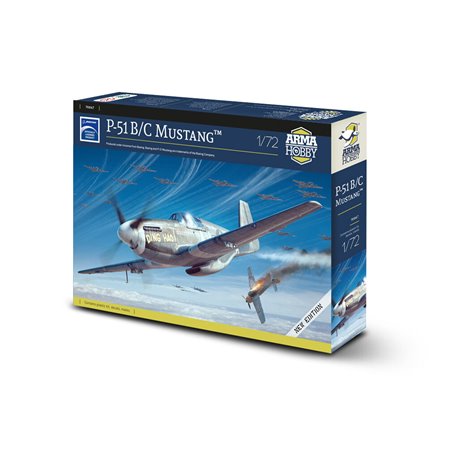No products
Product successfully added to your shopping cart
There are 0 items in your cart. There is 1 item in your cart.
North-America P-51B/P-51C Mustang 1/72 model kit
AH70067
Arma Hobby
North-America P-51B/P-51C Mustang
In stock
| Scale | 1:72 scale |
| Material | Plastic |
| Assembly | Kit |
| Finish | Unpainted |
More info
Kit includes:
- Plastic parts by Arma Hobby
- Canopy and wheels painting mask
- Decals with four colour options
Markings options:
- P-51B-5-NA Mustang, 43-6315/AJ-A, „Ding Hao”, pilot: Maj. James H. Howard MH, 356th Fighter Squadron, 354th Fighter Group, Boxted, UK. April 1944 r.
- Mustang III, KH516/WC-F, pilot: Kpt. Jerzy Mencel DFC, 309 Squadron Polish Air Forces, shot down Me-262 jet fighter, 9th April 1945.
- P-51C-10-NT Mustang, 43-25045/C3-W, „Snookie”, pilot: Lt. Edward T. Pawlak, 382nd Fighter Squadron, 363rd Fighter Group, France, July1944 r.
HISTORY:
During the air offensive over the Third Reich, the US Army Air Forces (USAAF) needed a good, low-cost long-range fighter to accompany the bombers at high altitude on their way to their targets. The first versions of the P-51/P-51A Mustang aircraft with the Allison engine performed well as a fighter and reconnaissance machine operating at low altitude, but the lack of a second engine compressor gear prevented satisfactory performance above 4,500m. P-47 fighters could not fly that far and P-38s were not available in sufficient numbers. The solution to this problem was to install in the P-51A airframe the British Rolls-Royce Merlin 66 engine (used in the Spitfire IX/XVI) with a two-stage compressor, already manufactured under licence in the USA at the Packard plant under the designation V-1650. The resulting version, the P-51B Mustang, was capable of flying from England to Berlin and solved the problem of escorting daytime bombing raids over Germany. Mass production of the new Mustang version was carried out at North American plants in California under the designation P-51B-NA and in Texas under the designation P-51C-NT. The aircraft of the production versions differed in minor details introduced as the design evolved, such as: an additional fuel tank behind the cockpit and a stabiliser fin through the vertical stabiliser. More than two hundred were converted into the photo-recognition version of the F-6C by fitting cameras in the fuselage behind the cockpit. A total of 3738 B and C version aircraft were produced. As many as 900 of these, under the designation Mustang Mk III, were transferred to the RAF and the Polish Air Force, RAAF, RCAF and Free French. British modifications included an improved cockpit fairing known as the Malcolm Hood (also introduced on the American P-51A and B/C), glare shields behind the exhaust pipes and gills on the dust filter openings. P-51B/C fighters were armed with 4 km of 12.7 mm calibre in the wings. They carried 250- and 500-pound bombs on under-wing attachments and 75-gallon aluminium fuel tanks and 108-gallon paper fuel tanks. P-51B/C Mustang aircraft entered service in the European theatre of operations in late 1943. They played a key role in breaking the resistance of German Luftwaffe fighter aviation in 1944. They also served in the Mediterranean and in the Burma-China theatre of operations. In addition to their escort duties, Mustangs performed ground support and V-1 missile combat operations. From mid-1944, they were gradually replaced by aircraft of the new P-51D/K version.



